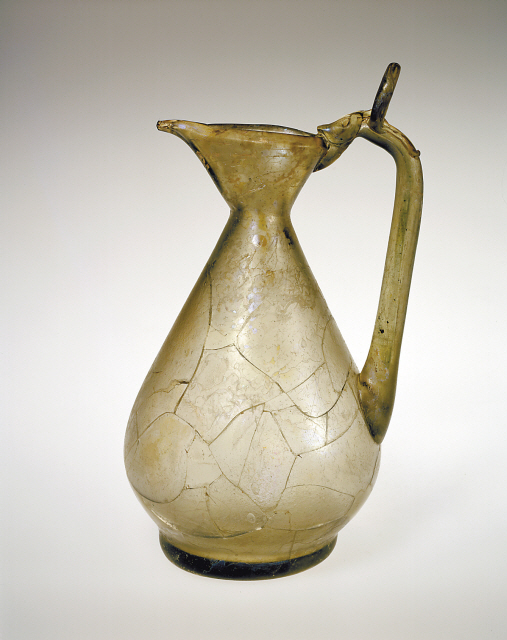Exhibition tracks down 3,000-year history of glass
From core-forming to glassblowing, glassmaking to fascinate visitors
By Korea HeraldPublished : Nov. 28, 2012 - 19:15

Glass has always been one of the most used materials for arts. Over 7,000 years, its ingredients, production methods and style may have changed, but glass has managed to attract people from around the world with its fragile but transparent beauty.
Chinese writer Wang Wei once said, “You embrace the light but has nowhere to hide it. You hold the cleanness but seem empty,” praising the abstruseness of the material.
The National Museum of Korea’s new exhibition, “History in Glass: 3,000 years of glassware from the Mediterranean and West Asia,” will be a good opportunity to observe the early faces of glass and the change of trends and patterns in its manufacturing. A total of 375 pieces owned by the Hirayama Ikuo Silk Road Museum in Japan will be presented to the public.
The exhibition follows the traits of glass development and its possible impact to ordinary lives as well as foreign countries including Korea.
In its first chapter, “The Beginning of Glassmaking,” the exhibition focuses on core-forming, casting and mosaic techniques, which were regarded as state-of-the-art skills then.
Chinese writer Wang Wei once said, “You embrace the light but has nowhere to hide it. You hold the cleanness but seem empty,” praising the abstruseness of the material.
The National Museum of Korea’s new exhibition, “History in Glass: 3,000 years of glassware from the Mediterranean and West Asia,” will be a good opportunity to observe the early faces of glass and the change of trends and patterns in its manufacturing. A total of 375 pieces owned by the Hirayama Ikuo Silk Road Museum in Japan will be presented to the public.
The exhibition follows the traits of glass development and its possible impact to ordinary lives as well as foreign countries including Korea.
In its first chapter, “The Beginning of Glassmaking,” the exhibition focuses on core-forming, casting and mosaic techniques, which were regarded as state-of-the-art skills then.

“Before, glass was not really the glass as we call it now. About 8,000 years ago, it was more of a ground obsidian. Then about 6,000 years ago, it moved onto being a stone with glaze pasted on the surface,” said Yang Hee-jung, curator of the exhibition.
The invention of the three techniques, believed to have taken place about 3,000 years ago in the Mesopotamian region then spread to Egypt, Syria and Palestine areas, made glass look more similar to the modern style of glass. Much of the products were pendants keep evil spirits away.
“People believed that glass with prints of a human face, or sometimes just an eye, would keep away bad energy,” Yang said.
“Mosaic inlay with ibis,” believed to have been manufactured around B.C. 1-A.D. 1; “Kohl tube,” which could hold eye makeup products; and “Mosaic hemispheric bowl” all represent the sophisticated craftsmanship of the era.
The invention of glassblowing has made possible a wide variety of shapes and techniques. Though glassblowing required lots of energy, the shape of the products was even and it took less time to manufacture a unit. Therefore, mass production became available, which made glass a material for commodity rather than luxury.
“At this time, glass played a pivotal role in international trade. Transport of wine, olive oil and other goods from Greece and Rome became feasible because glass was the perfect container,” the curator said.
Glass even reached a Far East Asian country ― Korea. The “Animal-headed rhyton” is identical to the relics found at old tombs of the Shilla Kingdom (B.C. 57-935) in the southern part of the country.
“We assume that the items were tributes to the royal family or trading goods from the faraway regions, proving the flourishing international trade the kingdom had,” Yang said.
But once mass production was introduced, glass demand declined in the Orient. Instead, the West, particularly Venice, took the lead in the industry, which is why many great glass products from Italy are remembered more than those from the oriental world.
“The amazing thing about glass is the fact that much of the production method is kept till now. If you take the ancient glass worker to now, or the other way around, they will still be able to produce glass without a problem,” Yang said. “This proves that glass always had a modern aspect and is timeless.”
The exhibition is held at the special gallery from Nov. 27 through Feb. 17 next year every Tuesday to Sunday. The museum is closed on Jan. 1, but is open until 9 p.m. on Wednesdays.
By Bae Ji-sook (baejisook@heraldcorp.com)
-
Articles by Korea Herald



















